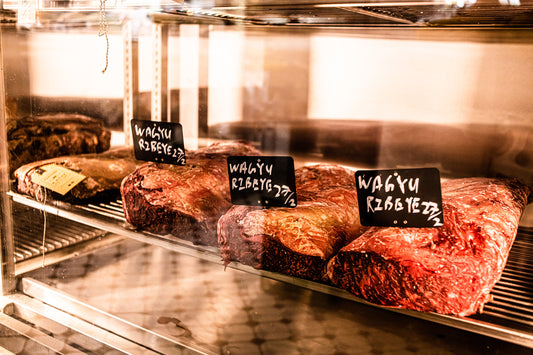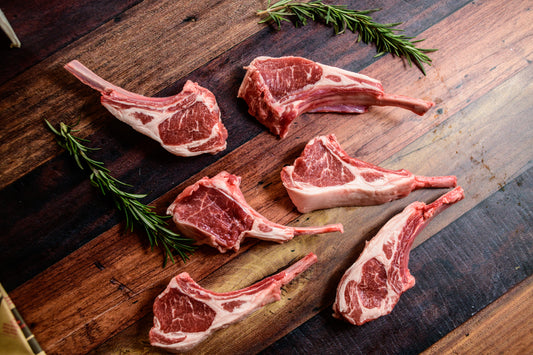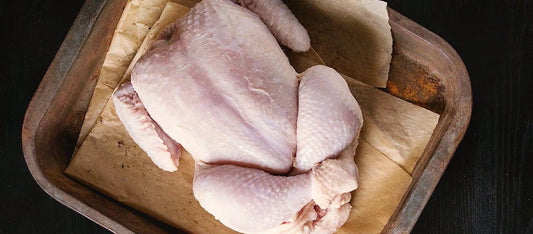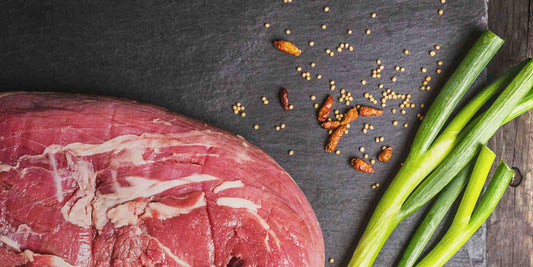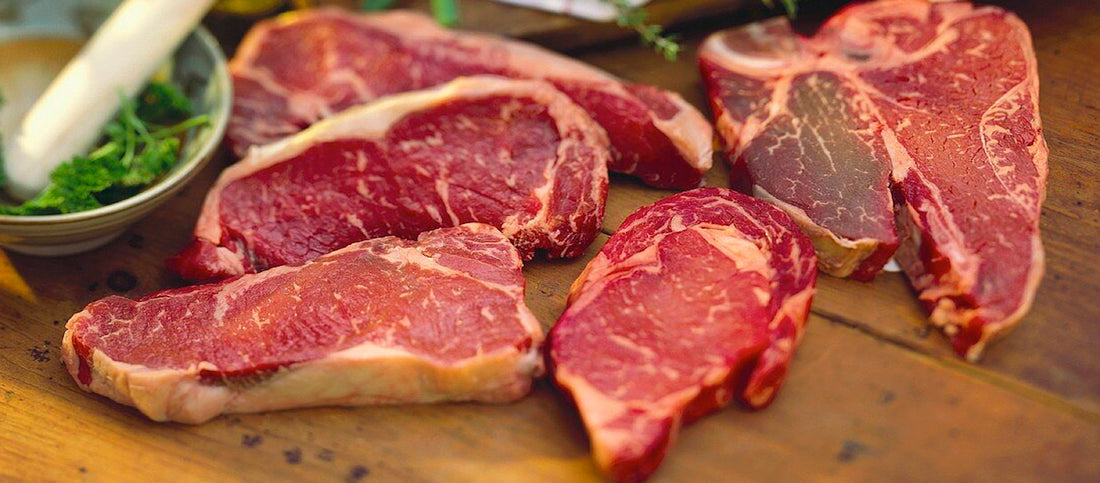
Guide to Cuts of Steak
Dining at a steakhouse can be a little daunting. The world of beef is wide and varied. There will be many steaks on the menu (or in our case, behind the counter) and you’d be forgiven for feeling a little overwhelmed by choice. How will you know which steak to order? What’s the difference between a tenderloin and a hanger? Just how big is a tomahawk? And then, when you finally do make a decision, there’s only another question waiting for you: “And, how would you like that cooked?” (FAB tip, don’t say steamed!)
So let us help do a little demystifying for you. A butcher’s counter 101, if you will, to walk you through the steaks on offer and give you a little boost of confidence to make your decision like a seasoned professional. And as our steaks are some of the most popular meat heading home with you all, we’ll run you through some cooking methods while we’re at it.
So go ahead, make your booking, and with our handy guide, you’ll be the one stepping up to order that gorgeous dry-aged rib-eye for the whole table.
Flank
a.k.a. Bavette, fajita steak, Philadelphia steak, London broil. Comes from the abdominal muscles or lower chest.
Although it is a working muscle, flank is quite tender when cut against the grain, so it’s a great option to sear then slice for fajitas, tacos, salads or steak sandwiches. Choose the piece with the most uniform thickness so that it cooks evenly, and go for medium-rare, about 4-5 minutes per side. Because it is a naturally thin steak, it’s also great marinated. And unusually for steak, flank can actually be cooked straight from the fridge. As it is so thin, being fridge cold gives a little extra time for the outside to develop a caramelised crust before the centre is overdone.
Hanger
a.k.a Onglet, butcher's steak, skirt, hanging tender. Hangs from the lower abdomen between the rib and the loin.
Someone let the cat out of the bag, and now hanger, which used to be a well-kept industry secret only butchers got to enjoy (hence its moniker of butcher’s steak), is fast becoming one of the most popular cuts of beef. As a supporting, rather than active muscle, hanger by its nature, is quite tender. Its loose, open texture makes it very receptive to marinades, that not only impart flavour, but with the inclusion of an acid (citrus, vinegar, wine…), can enhance that tenderness even further. Its intense, meaty character makes it ideal for serving with other strong flavours. Sear it to medium-rare, then pair with caramelised onion and horseradish in a signature steak sandwich.
Picanha
a.k.a Top sirloin cap, rump cover, rump cap, or culotte. It is from the back side of the animal above the butt, where it sits on a fat cap.
Picanha is a bit like a sirloin with a secret weapon – the fat cap. This thick layer of fat cooks together with the meat, becoming slightly gelatinous, intensely rich, and curiously addictive. Yes, you can eat the fat. It’s not an everyday food, but for a treat, there’s just nothing like it. Not an overused muscle, but the meat itself is relatively lean, so it’s not the most straightforward steak to cook - i.e. a great one to order in-store and leave the challenge to the pros.
Rib-eye
a.k.a Scotch fillet, cowboy steak, tomahawk steak, Spencer steak, Delmonico steak. Cut from the centre or ‘eye’ of the rib portion of the cow.
The football quarterback, the belle of the ball, the rock star frontman. This is the steak that requires no upselling. It has the perfect balance of fat-marbling to tender meat, for a rich, succulent, flavoursome end result. Because of the liberal marbling, the fine lines of fat running throughout the steak, (which is even more intense if you opt for grain-fed or wagyu) rib-eyes can stand up to a little longer cooking than leaner cuts. If you take your rib-eye to medium, the fat has a little bit longer to warm, soften and melt into the meat which surrounds it, imparting its flavour and texture all the while. Leave the long rib bone attached, and you’ve got a tomahawk and some serious wow factor.
Rump
a.k.a. Round. As the name suggests, it comes from the backside, right near the tail.
Rump steak is all about flavour. What’s sacrificed in tenderness is more than made up for by a deep, mineral savouriness that certain carnivores crave. As a working cut, you can expect a little more chew than tenderloin or rib-eye, but when cooked properly, it is a joy, and for less than half the price! It’s best served medium-rare to medium, (really rare, and it can be a little stringy). Our chefs give it 3 mins per side on a screaming hot griddle with a little neutral oil, then finish it in the oven for an extra 10-15 for succulent, flavour-packed perfection.
Sirloin
a.k.a. Strip steak, New York strip, Kanas City strip or Porterhouse in Australia/New Zealand. Steaks are cut from the loin of the beast which runs along the top of its back.
A strong contender for the coveted ‘most popular steak’ award, sirloin is a tender, succulent steak that grills beautifully. It is a great choice for those looking to stay on the leaner side of life, with a little less marbling than say, a rib-eye, but still a whole load of flavour. The fat is accumulated along one edge of the steak. It flavours the steak while cooking, but then the diner can choose to eat it or leave it. Like its more marbled cousin, sirloin is also a tremendous pan-frying steak. Head to our guide to cooking rib-eye, the same principles apply.
Skirt
a.k.a. Romanian Tenderloin, Philadelphia Steak, Arrachera. Skirt is a long thin, oddly shaped steak from the diaphragm with well defined, loose muscle fibres.
Skirt steaks have a little of everything. Their open texture makes them ideal for marinating – the marinade has lots of contact with the meat and so, imparts flavour readily. They are a relatively hard-working muscle which equals intense, beefy flavour, but when served rare or medium-rare and cut across the grain, they are still wonderfully tender. They also have a moderate amount of fat marbling, adding more flavour still and making them moist. A great steak for stir-fry, fajitas, or steak sandwiches. Three minutes in a scorching hot pan, six minutes rest, then cut against the grain. Done.
T-Bone
a.k.a. Porterhouse (in the US). The sirloin and the tenderloin run along a cow’s back on either side of a T shaped bone. If these two primals (fancy butcher’s term for the large pieces of meat that an animal is initially divided into) are left on the bone, then cut into steaks by sawing through that bone, you get… T-Bone steaks.
Two ultra-premium, first grade, tender steaks held together by a large ‘T’ shaped bone. This is the steak to order when you want to look like a cowboy, but you’re secretly a softy. We actually don’t recommend this cut for grilling on a pan or flat-top. In cooking, the meat shrinks a little, but the bone doesn’t. This causes the steak to lose contact with the pan breaking the searing process. If you’re having a BBQ, on the other hand, let those open flames work their magic!
Tenderloin
a.k.a. Eye fillet, filet mignon. Cut from the loin, the lowest working muscle in the cow, giving lean, meltingly tender steaks.
If your grandfather forgot to bring his dentures out for dinner, this is the steak for him. Soft, succulent, buttery and super tender. When we bring out your tenderloin, we only give you a steak knife so you feel like a big boy. You could nearly cut this one with a spoon! Low working muscles give steaks that are tender, low in fat and also with a beautifully mild flavour. The very centre of the tenderloin (the best of the best) is where we find the chateaubriand, the cut used for the famous Beef Wellington.
